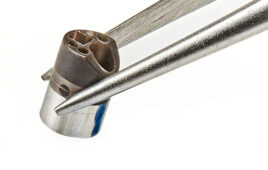An innovative new tool that resembles a wristwatch could improve the quality of life for patients with Parkinson’s disease and better inform neurologists who treat them.
A Cedars-Sinai research team is one of the first in the nation to test the Personal KinetiGraph (PKG) data logger, which tracks the movements of Parkinson’s patients every two minutes over a period of six-to-10 days.
The data enable neurologists to generate reports showing the fluctuations of Parkinson’s symptoms throughout the day and the timing of when patients take their medication.
Michele Tagliati, MD, director of the Movement Disorders Program in the Department of Neurology at Cedars-Sinai, said the device could be a game-changer for the treatment of patients with advanced Parkinson’s disease by providing an objective record of movement fluctuations.
Tagliati said such information can enhance doctors’ understanding of the nature and progression of the disorder, a brain disorder, which progressively affects a person’s ability to control body movements. Up to 60,000 new cases are diagnosed each year.
The small gadget – the size, weight and shape of a wristwatch – also vibrates to remind patients to press a button indicating that they have taken medication prescribed to reduce their body movements.
“This technology could help us as physicians better inform our patients of treatment options, such as when to have an aggressive therapy like deep brain stimulation,” Tagliati said. “A more refined approach to treating the symptoms of the disease will ultimately lead to a better quality of life for our patients.”
Currently, one of the biggest challenges neurologists face when managing Parkinson’s patients is making treatment decisions based on relatively brief patient interactions and subjective patient reports about symptoms.
“It’s virtually impossible to make a well-informed treatment plan based on how patients feel they have been doing in the last three months because often they don’t remember,” Tagliati said. “The PKG device provides a quantitative way to monitor and understand the fluctuations of movements in our patients when they are not in the office.”
Tagliati and his colleague, Echo Tan, MD, have sought to more fully understand the disease through their research. After the U.S. Food and Drug Administration cleared the watch-like device in late 2014, Tagliati and Tan launched a 60-patient clinical trial to study its effectiveness.
Tan said the preliminary findings have been valuable. She recalled one patient who said his medication stopped working after three hours even though the report generated by the watch device showed that the drug hadn’t worked at all. The information prompted Tan to change the patient’s prescription.
“It’s been very helpful by showing me what the patient is trying to describe,” Tan said.
The study includes patients at all stages of Parkinson’s disease. One of them, 74-year-old Robert Yelin, was among the first Parkinson’s patients in the U.S. to use the device. He credits it with providing an objective and accurate log of his fluctuations for Dr. Tagliati.
“The watch works great,” Yelin said. “It makes it more objective as opposed to subjective. Like the pain scale, for example. They ask you to rate your pain on a scale of 0 to 10 but my 5 might be your 9, or my 5 might be your 1.”




